Oregon
Authors: Ase & Hendrik Berg
Publisher: Hans im Glück
Year: 2007
review by
 / / 
| x |
|
|
|
|
|
|
|
|
|
|
|
|
|
|
|
|
|
|
|
|
|
|
|
|
|
|
|
|
|
|
|
|
|
|
|
|
|
|
|
|
|
|
|
|
|
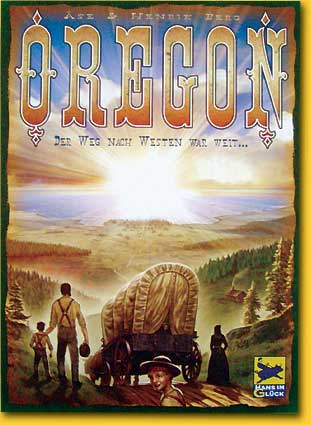 |
The players act as pioneers who colonise the last free space in Oregon. Each players tries to place his pioneers and buildings as profitable as he can for a high score. When one player has placed all of his pioneers on the board, or when a specific amount of chits have been depleted, the game ends.
The mapboard has a grid where each square either contains grass, mountains, water or railroad. The grid itself is divided into larger segments of squares, with symbols as x and y co-ordinates such as bison,wagon or fireplace. This way, areas of two by three squares large can be defined as bison-wagon, fireplace-bison, bison-bison, etc.
|
| x |
|
|
|
|
|
|
|
|
|
|
|
|
|
|
|
|
|
|
|
|
|
|
|
|
|
|
|
|
|
|
|
|
|
|
|
|
|
|
|
|
|
|
|
|
|
|
Each player has a hand of four cards, at least one of which has to be a building, and symbol cards. Further he has twenty wood pioneers at his disposal.
Each turn a player places a pioneer on the board, or he places a building; this is done by playing two cards and ccrossindexing the cards on the grid to define the area where he may place his pioneer, or by playing a symbol and a building.
|
|
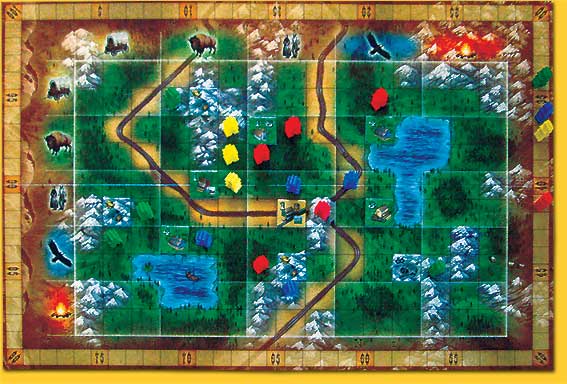 |
|
|
|
|
|
|
|
|
|
|
|
|
|
|
|
|
|
|
|
|
|
|
|
|
|
|
|
|
|
|
|
|
|
|
|
|
|
|
|
|
|
|
|
|
|
|
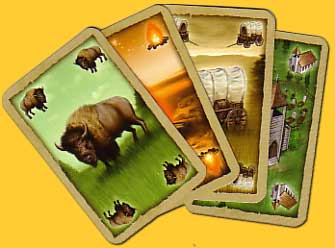 |
|
This way it gives him more freedom to place the building anywhere in the column or row of that symbol. All buildings each have their placement restrictions and score differently. |
|
|
|
|
|
|
|
|
|
|
|
|
|
|
|
|
|
|
|
|
|
|
|
|
|
|
|
|
|
|
|
|
|
|
|
|
|
|
|
|
|
|
|
|
|
|
| When a pioneer is placed next to a building, the points are rewarded for it. When placed next to a mine, the player may take the corresponding mine chit from a blind stock. Gold mines have chits varying from three to five points; cole mines go from one to three points. These chits are kept secret until the end of the game. |
 |
| x |
|
|
|
|
|
|
|
|
|
|
|
|
|
|
|
|
|
|
|
|
|
|
|
|
|
|
|
|
|
|
|
|
|
|
|
|
|
|
|
|
|
|
|
|
|
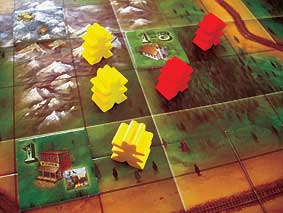 |
|
When a building is placed next to already placed pioneers, all adjacent pioneers score, so not only yours! Further, a group of three pioneers of one player score five points. At the end of a turn, a player refills his hand to four cards. When a player has placed all his pioneers, the game ends with the current round; the mine chits are added to the score and the player with the highest score wins. |
| x |
|
|
|
|
|
|
|
|
|
|
|
|
|
|
|
|
|
|
|
|
|
|
|
|
|
|
|
|
|
|
|
|
|
|
|
|
|
|
|
|
|
|
|
|
|
Until here ‘Oregon’ seems a rather standard game, which, quite frankly, it is. But the addition of the joker and the double turn chit feed the game with some tactics. The joker replaces any symbol and is played just like a symbol card; the double turn chit does just that: give the player an additional turn. Both chits are deactivated when used, but can be reactivated by scoring next to a train station or grocery store.
|
|
 |
 |
|
|
|
|
|
|
|
|
|
|
|
|
|
|
|
|
|
|
|
|
|
|
|
|
|
|
|
|
|
|
|
|
|
|
|
|
|
|
|
|
|
|
|
| ‘Oregon’ offers each player a chance to score every turn, but this requires efficient use of the cards, with the additional consideration of when to make use of the special chits. Making the right combination, using the double turn chit to place a pioneer next to a building that reactivates the chit at the same time does not only give a good feeling, but also a high score! The down side of scoring by placing a building next to pioneers is that every other pioneer, including those of other players, also score. |
 |
| x |
|
|
|
|
|
|
|
|
|
|
|
|
|
|
|
|
|
|
|
|
|
|
|
|
|
|
|
|
|
|
|
|
|
|
|
|
|
|
|
|
|
|
|
|
|
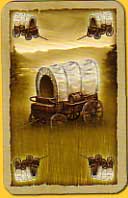 x x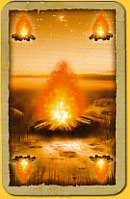 |
|
Ofcourse ‘Oregon’ only very vaguely has something to do with the Oregon Trek to the West, that usually is depicted very romantically but at the same time involved the massive and violent deportation of thousands of native Indians from their home land. Apparently it has to do with who is (re)writing history, because this is one of the marks of infamy in (unprocessed) American History. By the way, and at the risk of being rude: could this be why the U.S. still protect Israel in their policy of migrating the Palestinian people, where the latter already for decades now are pushed further and further into the margins of society up to a level where decent living ceases to exist? |
| x |
|
|
|
|
|
|
|
|
|
|
|
|
|
|
|
|
|
|
|
|
|
|
|
|
|
|
|
|
|
|
|
|
|
|
|
|
|
|
|
|
|
|
|
|
|
Some players may find ‘Oregon’ too dependent on the cards a player draws from the deck, or too much ado. Yet it offers a good mixture of luck and tactics, and due to its short playing time it will surely appeal to a broader audience.
© 2007 Marijn Vis / Richard van Vugt |
|
| x |
|
|
|
|
|
|
|
|
|
|
|
|
|
|
|
|
|
|
|
|
|
|
|
|
|
|
|
|
|
|
|
|
|
|
|
|
|
|
|
|
|
|
|
|
|
Oregon, Ase & Hendrik Berg, Hans im Glück, 2007 - 2 to 4 players, 8 years and up, 45-60 minutes
|
|
|
|
|
|
|
|
|
|
|
|
|
|
|
|
|
|
|
|
|
|
|
|
|
|
|
|
|
|
|
|
|
|
|
|
|
|
|
|
|
|
|
|
| x |
|
|
|
|
|
|
|
|
|
|
|
|
|
|
|
|
|
|
|
|
|
|
|
|
|
|
|
|
|
|
|
|
|
|
|
|
|
|
|
|
|
|
|
|
|
| x |
|
|
|
|
|
|
|
|
|
|
|
|
|
|
|
|
|
|
|
|
|
|
|
|
|
|
|
|
|
|
|
|
|
|
|
|
|
|
|
|
|
|
|
|
|
 |
|
|
|
|
|
|
|
|
|
|
|
|
|
|
|
|
|
|
|
|
|
|
|
|
|
|
|
|
|
|
|
|
|
|
|
|
|
|
|
|
|
 |
|
|
|
|
|
|
|
|
|
|
|
|
|
|
|
|
|
|
|
|
|
|
|
|
|
|
|
|
|
|
|
|
|
|
|
|
|
|
|
|
|
| x |
|
|
|
|
|
|
|
|
|
|
|
|
|
|
|
|
|
|
|
|
|
|
|
|
|
|
|
|
|
|
|
|
|
|
|
|
|
|
|
|
|
|
|
|
|
 |
|
|
|
|
|
|
|
|
|
|
|
|
|
|
|
|
|
|
|
|
|
|
|
|
|
|
|
|
|
|
|
|
|
 |
|
|
|
|
|
|
|
|
|
|
|
|
|
|
|
|
|
|
|
|
|
|
|
|
|
|
|
|
|
|
|
|
|
|
|